

In a sense, I began gardening long before I was old enough to take up spade and fork. Even as a child, flowers were a special thing in my life. Some of my earliest memories are floral visions: wild flowers that grew beneath my bedroom window when I was a toddler living in the country; the irises that flourished at my grandmother's house; lilies of the valley along my great-aunt's shady sidewalk. I held these gossamer memories for nearly a quarter of a century before they took solid shape in actual beds and borders.


I spend much of the dreary upstate New York winter reading and dreaming about gardening, biding my time until spring. This winter I was introduced to the works of Henry Mitchell (1923-1993), who for nearly 25 years was a gardening columnist for the Washington Post. The following passages, excerpted from his Earthman columns, speak of the nature of gardeners and the universal appeal of gardens. I share them here because Mitchell's view echoes my own.
"There are no green thumbs or black thumbs. There are only gardeners and non-gardeners. Gardeners are the ones who ruin after ruin get on with the high defiance of nature herself, creating, in the very face of her chaos and tornado, the bower of roses and the pride of irises. It sounds very well to garden a "natural way." You may see the natural way in any desert, any swamp, any leech-filled laurel hell. Defiance, on the other hand, is what makes gardeners." (from On the Defiance of Gardeners)
"Gardening is not some sort of game by which one proves his superiority over others, nor is it a marketplace for the display of elegant things that others cannot afford. It is, on the contrary, a growing work of creation, endless in its changing elements. It is not a monument or an achievement, but a sort of traveling, a kind of pilgrimage you might say, often a bit grubby and sweaty though true pilgrims do not mind that. A garden is not a picture, but a language, which is of course the major art of life." (from Up and Down the Garden Path)
Please stroll through the gardens with me, and come back again to visit. Pictures will be updated as the growing seasons progress.

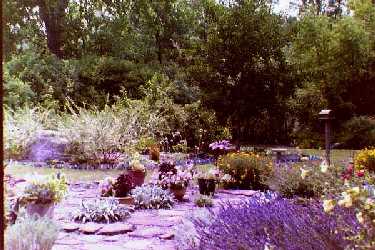 |
This is a flagstone cirque leading to a sidewalk off to the right. It is a riot of color throughout spring, summer, and fall, though purple predominates in this photo. The spaces between the flagstones eventually will be colonized by sempervivums and other low-growing species. In the meantime, some of the space is filled by various containers. |
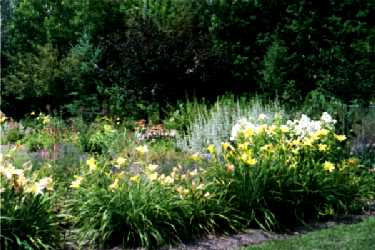 |
The North Garden is planted primarily with shrubs and perennials. This photo does not show clearly that the garden is a 3-sided rectangle with a grassy area in the center - this is but one corner. The north side of my house constitutes the fourth side. Outside the rectangle, among the trees you see here, is a new area I am in the process of developing. |
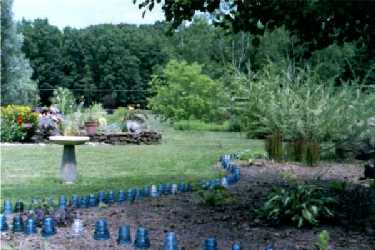 |
I planted this hosta bed in 1999 with seedlings grown under artificial light during the winter. As the seedlings are fairly slow-growing, they were not very visible when I took this photo. The bed is edged with a "necklace" of old glass insulators found at a yard sale. Some say it looks tacky, but I prefer to think of it as "festive". The insulators sparkle even on gloomy days. |
 |
I grow many annuals and perennials not only for their colorful blossoms, but for the food value of their seed heads and the interest they provide in winter. Echinacea 'Magnus' is, for me, a rather muddy magenta, but the finches don't seem to care. Cosmos and annual Centaurea are other finch favorites. There is nothing prettier than gold finches fluttering amongst blue bachelor buttons. |
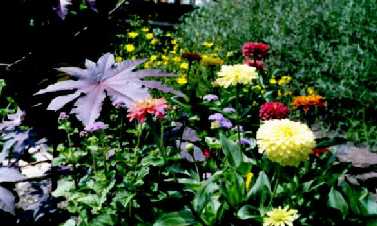 |
A bed along the sidewalk is planted in annuals every year for abundant and reliable bloom. Tall-growing Zinnias are a mainstay, and I will never be without some variety of Ricinus (castor bean) for the bold effects of their exotic foliage. Castor beans are highly toxic; do not plant them in an area where your children and pets will play. |
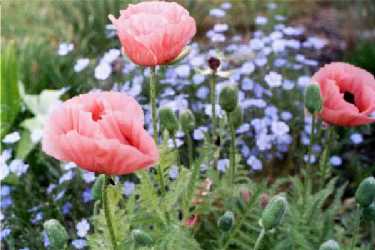 |
Although the blooms are shortlived and the foliage goes through an ugly phase before it disappears entirely in midsummer, Oriental poppies are among my favorite June flowers. Their silken petals seem oddly incongruous with such sturdy stems. An attractive companion, as shown in this picture, is perennial flax, linum perenne. |
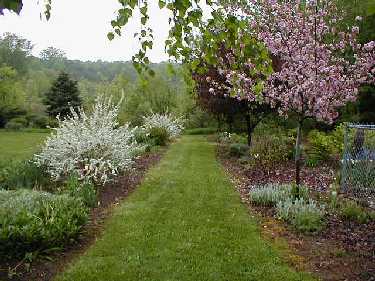 |
This row of flowering crabapple trees divides the two gardens on the north side of the house. My plan is someday to plant a parallel row and thereby create an "all�". (I wish I had thought of it ten years ago!) The graceful flowering shrubs are old fashioned Bridal Veil, which I transplanted from the wild; they were undoubtedly escapees from a nearby garden. Their glory is not confined to spring - the leaves turn crimson in the fall! |
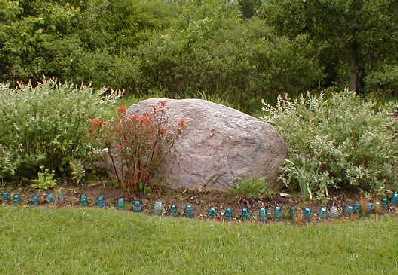 |
This pink granite boulder, weighing roughly 8 tons, is at the east end of the Insulator Garden. Planted on each end is Salix integrifolia 'Hakuro Nishiki', whose leaves are tipped in shrimp pink in late spring. These shrubs must be pruned heavily to keep them small. The orange-flowered plant is Euphorbia griffithii 'Fern Cottage'. Euphorbias are a fascinating genus which includes the familiar poinsettia plant, E. pulcherrima. |
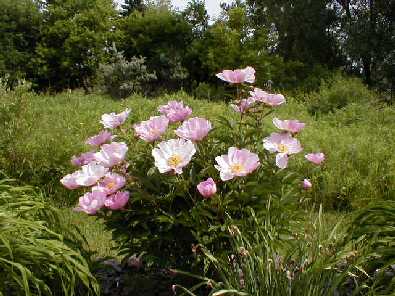 |
I do not know the full identify of this exquisite single-petalled peony. She appeared several years ago in a clump of field-dug iris rhizomes. Her fragrance mingles in a heady medley of wild roses and valerian which sing the prelude to summer. If there is a heaven, this is what it smells like! |

 |
 |
 |
 |
 |
 |
||
| Sign Guestbook View Guestbook | Please E-Mail me! |

 This GeoCities Gardening Ring site is owned by
This GeoCities Gardening Ring site is owned by Chey. Want to join the GeoCities Gardening Ring? |
|---|
| [Skip Prev] [Prev] [Next] [Skip Next] [Random] [Next 5] [List Sites] |